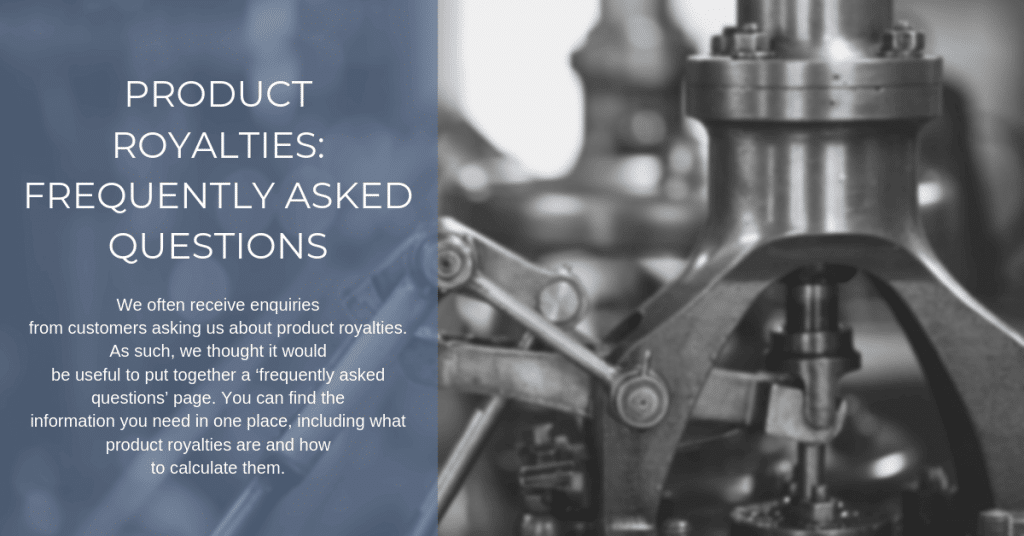Product royalties: frequently asked questions
October 16, 2019

We often receive enquiries from customers asking us about product royalties. As such, we thought it would be useful to put together a ‘frequently asked questions’ page. You can find the information you need in one place, including what product royalties are and how to calculate them.
If you are looking for third-party product royalties data, you can use the RoyaltyRange database. Whether you are carrying out a transfer pricing analysis or drafting a license agreement, simply scroll to the bottom of this page and enter your search terms to find real licenses and royalty rates.

Q: What are product royalties?
A: A product licensing royalty is a fee a licensee pays a licensor for the rights to make, use or sell a product. This product could be anything from ice cream to a medical scanner for detecting disease. The royalties are usually paid as a percentage of the revenue generated by the licensed product.
The product may be patented, which means that the invention is protected and cannot be copied.
The licensor may license the whole product or a component of it (e.g. the technology it uses).
Q: How do product royalties work?
A: Usually, product royalties are agreed as a percentage of sales. So, the licensee must pay the licensor an agreed percentage of the revenue they earn from using the product. This means that the licensor can benefit from their invention without having to continue working on it. The licensee, on the other hand, can earn from a product without having to spend time inventing it.
Organizations can use different royalty bases, but the most common are gross or net revenue.
Royalty percentages are not the only option. Product royalties can also be agreed as a fixed fee.
For more information on this, check out our blog: What are royalty rates?
Q: Do product licensing royalties differ by industry?
A: Product royalties can differ significantly by industry, even for similar products. While some industries invite a premium rate, others encourage lower royalties. As such, when setting royalty rates or transfer prices, it is important to consider the industry into which the product will be sold.
To give you an idea of what products might be licensed in various industries, we have collected a few examples from our database:
- Food: An organization may license trademark and brand assets for dairy-free ice cream to enable the licensee to manufacture and sell the products under the licensed trademark.
- Agriculture: An inventor has developed a seed coating polymer product that they have licensed to a third party, who now has the rights to use the trademark and technology.
- Apparel: A designer licenses their trademark and patent rights to a clothing retailer to enable them to develop, manufacture, sell and market the designs as part of their men’s and women’s apparel.
- Medical: A licensor licenses their know-how and patent rights to enable the licensee to develop products for the treatment of depressive disorders using the patented technologies for transcranial magnetic stimulation.
You can find existing product royalties for hundreds of industries in the RoyaltyRange database. It covers everything from accommodation and advertising to construction, packaging and software.
Q: Do product royalties cover patents, technology and other intellectual property rights?
A: This depends on what’s included in the license agreement (see ‘What is a product royalty agreement?’ below).
All sorts of intellectual property goes into developing a product – for example, know-how, patents, trade secrets and technology. These intellectual property types can all be licensed, and licensees must pay the licensors royalties for their use.
Many license agreements bundle together the different intellectual property types. For example, a license agreement for a product designed for the agricultural industry might include the rights to use the licensor’s patents, trademark and technology to develop the product.
Q: What is a product royalty agreement?
A: A product royalty agreement or license agreement is the official contract drawn up between a licensor and licensee. It details the exact terms and conditions of the licensing deal, as well as the agreed remuneration for the licensee’s use of the product. The license agreement will specify:
- The IP type being licensed
- The name of the licensor and licensee
- A description of the product and intellectual property being licensed, and for what purpose
- The geographical scope of the license
- The date of agreement, effective date and cessation date, and duration terms
- The exclusivity of the license
- Remuneration terms (including royalty rate, royalty base and other payments)
Q: Can third-party product royalties help with my transfer pricing analysis?
A: Yes. When carrying out a transfer pricing analysis, third-party comparables data can help you determine arm’s length prices. This is called the Comparable Uncontrolled Price (CUP) method.
Under the CUP method, you compare the price for the transfer of your product to a related entity and the price agreed in a comparable uncontrolled transaction between independent parties. You can see the product royalties agreed in comparable transactions by viewing the license agreements.
Q: Where can I find real third-party product royalties?
A: Whether you need product royalties for transfer pricing or license drafting purposes, you can find the data you require in the RoyaltyRange database. You can use One Search to get a full report of comparable license agreements and royalty rates, or order a benchmarking study for an in-depth comparison of royalties for your industry. Scroll to the bottom of this page to get started.




